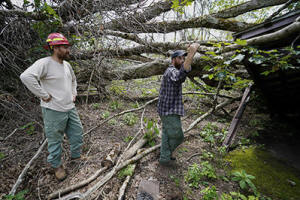Volunteers repair damaged parts of Appalachian Trail by hand almost a
year after Helene
[July 26, 2025]
By ERIK VERDUZCO and MAKIYA SEMINERA
UNICOI COUNTY, Tenn. (AP) — In a rugged patch of the Appalachian Trail
in eastern Tennessee, volunteers size up a massive, gnarled tree lying
on its side. Its tangled web of roots and dark brown soil, known as a
root ball, is roughly the size of a large kiddie pool.
The collection of volunteers and staff from the Appalachian Trail
Conservancy and local organizations, doesn't plan to move the tree.
Instead, their job is filling the gaping holes left by it and many other
downed trees along iconic East Coast trail.
Almost a year since Hurricane Helene tore through the mountains of the
Southeast, restoration is still ongoing. In places like the Appalachian
Trail it's powered primarily by volunteers, at a time when federal
resources are strained and uncertain. That labor, made up of people
spanning several generations and continents, aims to not only return the
trail to its former glory but make it more resilient against future
inclement weather.
“Volunteers are the lifeblood of the Appalachian Trail,” said Jake
Stowe, a program support specialist with the Appalachian Trail
Conservancy.
Stretching more than 2,000 miles (3,200 kilometers) miles from Georgia
to Maine, the trail attracts more than 3 million people every year,
according to the conservancy. Some committed hikers traverse its entire
length to cross it off their bucket list. Others visit sporadically just
to indulge in its scenic views.
Last September, Helene killed more than 200 people and wrecked entire
towns. Many rural businesses have struggled due to the drop in tourism,
Stowe said, such as in places seeing fewer trail hikers. Directly after
the storm, more than 430 miles (690 kilometers) of the trail were
closed, the conservancy said. That's down to 5 miles (8 kilometers)
today.
Hikers still have to take detours around two damaged sections of the
trail, both in Tennessee, according to the conservancy.

One spot where a bridge collapsed requires a 3.6-mile (5.8-kilometer)
walking detour. The other location is near the destroyed Cherry Gap
Shelter, where an Associated Press journalist accompanied volunteers
this week making the area passable again for visitors who currently have
to take a 6-mile (10 kilometer) detour.
Fixing trails is hard work
Local groups typically take on day-to-day trail maintenance, such as
hacking back plant overgrowth, Stowe said. Larger organizations like the
Appalachian Trail Conservancy step in to assist with severe damage,
although in Helene's case, safety concerns delayed restoration.
“At the time, we weren't really in the position to put people in the
woods,” Stowe said. “It was such bad damage that it was just- you
couldn't safely do that.”
The area near Cherry Gap has already been “sawed out,” meaning downed
trees that blocked the trail have been cut and moved out of the way. But
root balls are still a major problem because of how labor-intensive it
is to deal with them.
When a tree tips over, the root ball lifts a big chunk of earth with it.
Filling that hole can sometimes take a week, said Matt Perrenod, a crew
leader with the conservancy. The trail runs along the spine of the
Appalachian Mountains, and that rough terrain means crews must rely on
hand tools like shovels, rakes and pruners to do the job, rather than
heavy equipment.
[to top of second column]
|

U.S. Forest Service Forestry Recreation Program Manager Chad Ingle,
left, and Technician Brandon Church, access damage to the Cherry Gap
Shelter along the Appalachian Trail during a trail rebuilding
project, July 22, 2025, in Unicoi, Tenn. (AP Photo/Erik Verduzco)
 The conservancy also has to consider
more sustainable improvements to the trail, such as building steps
or features like water bars, which are essentially little ditches
that divert rainfall off the side of the trail.
It's a slow process, Perrenod said, but a worthwhile venture to
improve the experience of hikers.
“You don't actually want to think about the thing you're walking on
very much. You just want to walk on it," said Perrenod, who hiked
the Appalachian Trail's entirety about a decade ago. “Well, if we
don't do the work, you won't be able to do that. You'll spend all
your time climbing over this tree and walking around that hole."
Volunteers travel the world to help out
Partnering with the U.S. Forest Service and the National Park
Service has long been a critical component of preserving the
Appalachian Trail. Through contracts, Perrenod said the agencies
fund equipment, gas and the wages of some Appalachian Trail
Conservancy staff members like himself. The Forest Service also
helps the group lug their gear up to the trail, he said.
That's why Perrenod says it's imperative the federal government does
not slash those agencies' budgets and workforces. Disrupting support
for volunteers could be detrimental for the trail's restoration, as
volunteers provide “a lot of muscle” to complete the vast majority
of its maintenance, he said.
In Helene's aftermath, volunteerism across the region was “super
high” because everyone wanted to help, Stowe said. This year,
interest in volunteering has dipped, Stowe said, but he's heard from
people all over the country — and the world — who cited Helene as a
major reason they wanted to come out and help.
Among the volunteers on the July maintenance trip were three
visitors from Japan who work on long-distance trails back home. They
were enthusiastic to learn about best practices for improving trail
longevity and take those ideas back to Japan.
The trio was also motivated by their own experience with natural
devastation. After Japan's massive 2011 earthquake and tsunami,
volunteer Kumi Aizawa said people from across the globe came to
rebuild.
By restoring part of the Appalachian Trail, she's returning the
favor.
___
Seminera reported from Raleigh, North Carolina.
All contents © copyright 2025 Associated Press. All rights reserved
 |